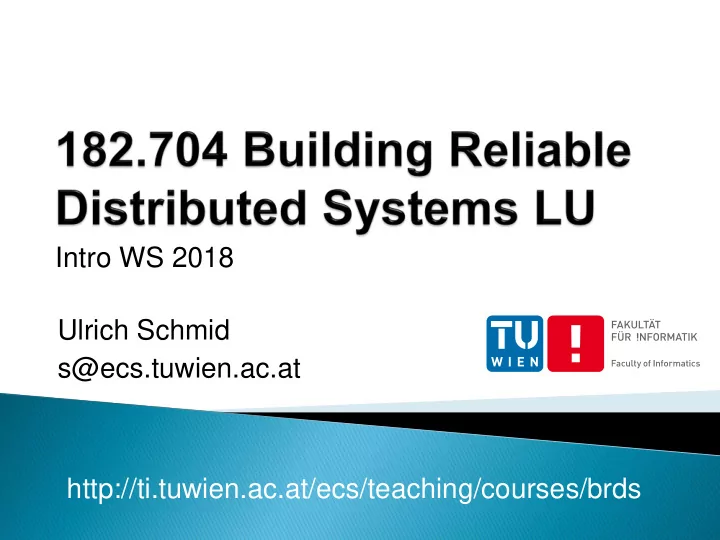

Intro WS 2018 Ulrich Schmid s@ecs.tuwien.ac.at http://ti.tuwien.ac.at/ecs/teaching/courses/brds
RTOS hands-on experience Connect distributed algorithms theory and practice U. Schmid 182.704 BRDS 2
U. Schmid 182.704 BRDS 3
http://www.omappedia.org/wiki/PandaBoard U. Schmid 182.704 BRDS 4
U. Schmid 182.704 BRDS 5
Install your prefered RTOS on the Pandaboard • QNX Neutrino • RT-Linux (Ubuntu) • Your favorite other RTOS. Caveat: Watch out for existing Pandaboard BSP! Need to provide additional resources (doc links, architecture and feature overview slides) Install cross-development environment Measure local (timer-)event service time latency Expected additional results: • Setup.txt : Detailed install instructions and configuration choices • Lab protocol (or slides): Description of latency measurement setup and results U. Schmid 182.704 BRDS 6
Want to run • asynchronous • synchronous distributed algorithms on networked embedded system Low-level communication: Either via Ethernet or 802.11 U. Schmid 182.704 BRDS 7
Synchronous distributed algorithm Lock-step Asynchronous rounds Sync message distributed bcast/rcv algorithm Clocksync Async unicast message send/rcv (unreliable/reliable) RTOS Device Drivers Timers 802.3 802.11 UART IO-Ports U. Schmid 182.704 BRDS 8
Devise system configuration and node addressing scheme Implement asynchronous unicast message passing interface (both unreliable and reliable) Implement clock synchronization algorithm Implement lock-step round abstraction and synchronous broadcast message passing IFC Expected additional results: • Lab protocol (or slides): Overview of architecture and design of your solution, including the interface to the RTOS U. Schmid 182.704 BRDS 9
Implement simple asynchronous distributed algorithm. Note that the CS algorithm would also do Measure end-to-end delays (and termination times) Implement simple fault-tolerant synchronous distributed algorithm Measure clock synchronization accuracy and evaluate termination time and reliability Expected additional results: • Lab protocol (or slides): Overview of specification and implementation of your algorithms and evaluation results. • Presentation (15-25 min) of your solution and results in one of the students ‘ presentations U. Schmid 182.704 BRDS 10
Groups of 2 students are prefered Every group gets 2 Pandaboards that can be carried home (until Task 3 integration tests start) You can (also) work in the ECS lab (2nd floor), which you can access using your TI chip card (will be enabled) If you select QNX Neutrino, you need to sign a non-disclosure agreement You can choose the date of your presentation (every Thursday 14:15-15:45), but please send us an email one week before so that we can enter your name + RTOS into the schedule Your attendance in the others ‘ student presentations is welcome but not mandatory You must upload code, setup.txt and lab protocol to subdirectory „BRDS“ in your ECS lab homedirectory (will be created). Make sure that the whole subtree has group „ brds “ and is read- and writeable for the group! U. Schmid 182.704 BRDS 11
Recommend
More recommend